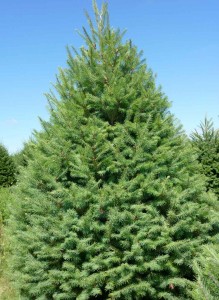
This wide ranging species grows from 70 to 250 feet tall. The branches are spreading to drooping, the buds sharply pointed and the bark is very thick, fluted, ridged, rough and dark brown.
The needles are dark green or blue green, 1 to 1 1/2 inches long, soft to the touch and radiate out in all directions from the branch. They have a sweet fragrance when crushed.
Uses:
The Douglas-fir has been the major Christmas tree species used in the Pacific Northwest since the 1920’s. During the following 40 years, nearly all trees were harvested from forest lands. Since the 1950’s, the transformation from growing trees in the wild to culturing them on plantations has been dramatic. Today, few trees come from forest lands.
An interior strain from the Rocky Mountains (P. menziesii var. glauca) has been extensively planted throughout several midwestern state Christmas tree plantations. It is preferred because of its ability to withstand the more harsh growing conditions than the Pacific Northwest seed sources.
Nationally, it remains one of the most popular Christmas trees species. It is shipped to the majority of the states and is also exported to the Hawaiian Islands, Guam and some Asian markets.
Plantation trees are normally sheared and will produce a crop within 7 to over 10 years depending upon the site and growing area.






